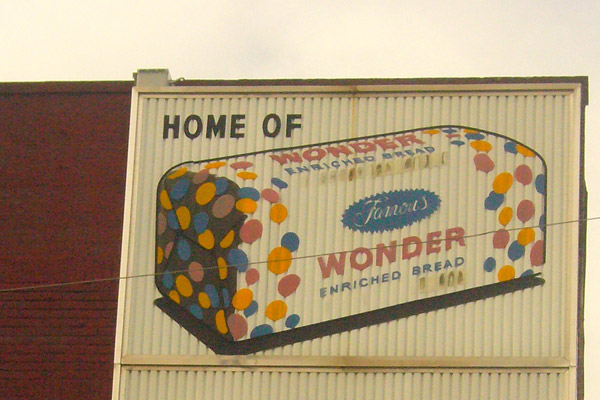
When I was a kid, I also hated whole-grain bread. This shouldn't be surprising, since kids have a narrow, safe palate; it's part of growing up. My mom tried to foist dry, brown, healthy bread on me, but I preferred the damp, light fluffiness of the white stuff. As I've grown older, my tastes have changed, along with the country. The moms won out, and it devastated Hostess, maker of Wonder Bread, which was late to the whole-grain market; its healthy offering, Nature's Pride, didn't roll out until 2008; two premium regional breads ("Home Pride Country" and "Grandma Emilie's") debuted shortly before the company's 2004 bankruptcy.
Hostess is in its second bankruptcy in eight years, and seeking to liquidate. Many things have contributed—rising health care costs, rising ingredient costs, low-carb diets, and the fact that Twinkies really, really aren't good. (I am definitely not averse to terrible snack food, but Twinkies—c'mon—taste like kerosene.)
But science didn't just kill its unhealthy products by leading consumers away from white bread, or away from bread altogether. Hostess (then Interstate Bakeries Corp.) decided, as America was moving towards healthier whole-grain breads, to magically make Wonder Bread and Merita even worse in a cost-cutting effort. They tried to make it last a week on shelves, and it was a failure:
The shelf-life program began when company food technicians decided to deconstruct a crumb cake that seemed to stay fresh forever. Examining its recipe, the researchers found the cake included an ideal amount of a gum whose role was to keep it extra-moist. With great caution, they decided to try adding more of that ingredient to Zingers, a Dolly Madison cake. "One of the scariest things in the food business is to change your recipe," says Mr. Dirkes.
That worked fine, and the shelf life of Zingers doubled. But no one is eating something called "Zingers" for health or quality. (Self-loathing, perhaps.) But people do have standards, if marginal, for bread.
Interstate experimented with the Innovative Cereal formula and determined that it worked in Wonder Bread, the nation's top-selling brand. In 2001, Interstate began shipping Wonder loaves that could stay soft and fresh for seven days, more than twice as long as before.
Company officials saw the rollout as clearing the way for a huge cost-cutting program. Bread always had been so perishable that the company had operated more than 60 bakeries, so no truck had to drive very far. Now, executives envisioned shutting plants right and left, and reducing deliveries by 10%.
Officers told Wall Street the program would permit cost cutting like never before. "Our extended-shelf-life program will continue to play a significant role in cost control, with the added benefit of improved quality and availability of our products," said Charles Sullivan, former chairman and chief executive, three years ago.
Sometimes the recipe didn't work. Sometimes it did, but keeping bread on the shelf for a week, its marshmallow consistency pawed over by hundreds or thousands of customers, left the concoction in sad little lumps on the shelves.
Mitchell Pinheiro, a food analyst with Janney Montgomery Scott, says he was touring an Atlanta supermarket in June 2003 when he noticed that Interstate's Merita bread looked gummy and doughy. "It was so heavy that the sides weren't able to support the weight," Mr. Pinheiro says. He questioned a delivery driver, who, he recalls, thought the bread never should have made it to store shelves.
"So heavy that the sides weren't able to support the weight." Mmm. Did I mention it was a week old?
Science—and the government—created the market for enriched white breads like Wonder Bread, as Aaron Bobrow-Strain details in his lengthy history of the foodstuff for The Believe. It was not entirely ill-conceived; initially, it was meant to address widespread vitamin deficiencies among the poor:
A government commission convened to study war readiness found that 75 percent of low-income high-school students suffered from vitamin B2 deficiencies, and 65 percent of WPA workers suffered from scurvy or near scurvy. Another report revealed that 54 percent of a sample of low-income whites and blacks suffered from night blindness characteristic of vitamin A deficiency—a statistic that terrified war planners looking ahead to combat conditions. Meanwhile, pellagra—the vitamin-deficiency disease most closely, if incorrectly, associated with bread-eating habits—killed twenty thousand Americans and debilitated well over one hundred thousand between 1933 and 1938.
Then as now, Americans ate lots and lots of cereals, so pumping bread full of vitamins was an obvious solution. Not just to address a health crisis, but a national-security one: "Synthetic enrichment was, they conceded, the quickest way to rush vitamins to almost every American, almost every day—without needing to change the country's tastes or upset its milling and baking industries."
More recently, the backlash against refined grains (the kind that get hell of refined for Wonder Bread) in favor of whole grains has reversed the government's enriched-bread-against-Hitler effort. And it's a very recent development:
Within the past 20 y, substantial evidence has accumulated showing that long term consumption of high glycemic load carbohydrates [i.e. refined grains and sugars] can adversely affect metabolism and health. Specifically, chronic hyperglycemia and hyperinsulinemia induced by high glycemic load carbohydrates may elicit a number of hormonal and physiologic changes that promote insulin resistance. Chronic hyperinsulinemia represents the primary metabolic defect in the metabolic syndrome. Diseases of insulin resistance are frequently referred to as “diseases of civilization” and include: obesity, coronary heart disease (CHD), type 2 diabetes, hypertension, and dyslipidemia [elevated serum triacylglycerols, small-dense, LDL cholesterol and reduced HDL cholesterol].
It didn't help matters that the glycemic index was set to use white bread as its baseline.
Science helped create Wonder Bread. It also brought it down—and some of the damage was self-inflicted.
Photograph: paperocks a.k.a. evelina (CC by 2.0)


